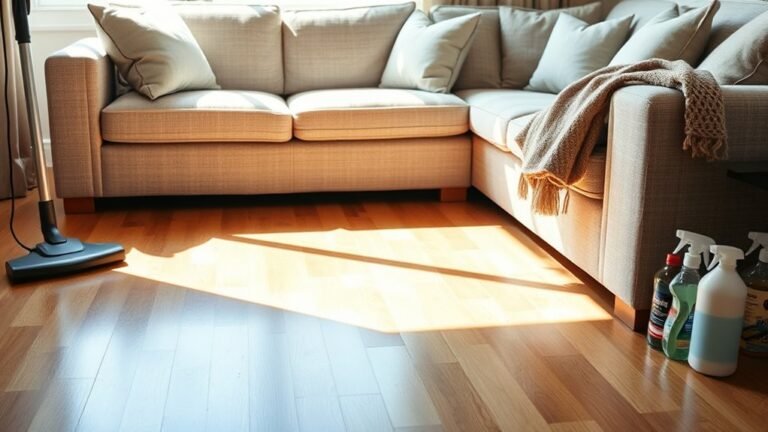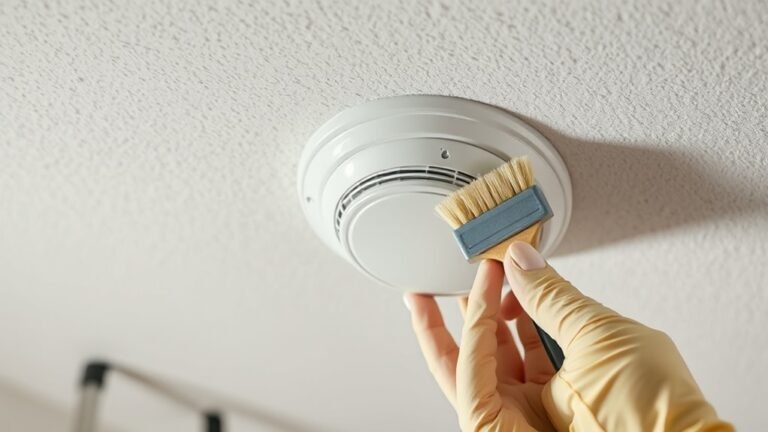How to Clean Your Attic Safely
To clean your attic safely, start by clearing out stored items and inspecting for hazards like nails or mold. Wear protective gloves, goggles, and a mask to guard against dust and pests. Sort items into keep, donate, or trash piles, then vacuum fine dust with a HEPA filter. Organize what’s left using labeled bins for easier access. Following these steps will help you maintain a clean, safe attic, and there’s more to learn about keeping it that way.
Preparing Your Attic for Cleaning

Before you begin cleaning, make sure you clear out any stored items and check for hazards like exposed nails or insulation damage. Conduct a thorough attic inspection to identify areas that need attention and note any potential risks. Use a cleaning checklist to keep you focused and efficient—list tasks like dust removal, debris clearing, and ventilation checks. This way, you won’t miss anything important and can move freely without worrying about unexpected obstacles. Preparing your attic properly sets the stage for a smooth, safe cleaning process. By organizing your space and pinpointing hazards early, you gain the freedom to work confidently and efficiently, turning a challenging chore into a manageable task. Stay sharp, stay prepared, and enjoy the freedom that comes with a clean attic.
Essential Safety Gear and Equipment
Before you start cleaning, you’ll need the right safety gear to protect yourself from dust and debris. Make sure to wear protective clothing, use a suitable mask or respirator, and bring proper lighting to see clearly in dark corners. These essentials will keep you safe and make the job easier.
Protective Clothing Essentials
Although cleaning your attic might seem straightforward, wearing the right protective clothing is essential to avoid injuries and exposure to dust, insulation fibers, and pests. Start with sturdy protective gloves to shield your hands from sharp debris and irritating materials. These gloves give you the freedom to handle old insulation or scrap wood confidently. Don’t forget safety goggles—they protect your eyes from airborne dust and unexpected particles, letting you work without worry. Opt for long sleeves and durable pants to cover your skin fully, minimizing contact with irritants. Wearing proper clothing isn’t about restriction; it’s about empowering you to clean safely and efficiently, so you can enjoy the freedom of a clean, hazard-free attic space without risking your health.
Respiratory Protection Options
Breathing clean air is essential when tackling attic cleaning, as dust, mold spores, and insulation particles can pose serious health risks. To keep yourself safe and comfortable, you’ll want to choose the right respiratory protection. Respiratory masks designed for fine dust and allergens are a must-have. Look for masks with effective air filters that block harmful particles without restricting your breathing.
Consider these options:
- N95 respirators for everyday dust protection
- Half-face respirators with replaceable cartridges
- Masks with activated carbon filters for odors and chemicals
- Powered air-purifying respirators (PAPRs) for extended work periods
Proper Lighting Tools
Wearing the right respiratory protection helps keep your lungs safe, but good lighting is just as important to protect your eyes and prevent accidents. When choosing proper lighting tools for your attic, consider versatile lighting options like LED headlamps or portable work lights. These free your hands, so you can move easily and safely through tight spaces. Look for tool types with adjustable brightness and long battery life to guarantee clear visibility without constant interruptions. Avoid relying on overhead bulbs alone, as they often create shadows that hide hazards. By selecting the right lighting options, you maintain control and awareness, making your attic cleaning safer and more efficient. Remember, good lighting lets you work confidently, protecting your freedom to tackle any task without unnecessary risks.
Removing Debris and Unwanted Items
As you start clearing your attic, focus on sorting items into keep, donate, and trash piles to stay organized. Be sure to handle debris carefully and use proper disposal methods to avoid hazards. This approach will make the cleanup safer and more efficient.
Sorting and Categorizing Items
Sorting and categorizing items is an essential step in cleaning your attic efficiently. By applying smart sorting techniques and effective categorizing strategies, you’ll free up space and make future access easier. Start by dividing your items into clear groups that reflect their use and value. Consider these steps:
- Separate items into keep, donate, sell, or recycle piles
- Use bins or labels to mark categories clearly
- Group similar items together for quick retrieval
- Prioritize frequently used or sentimental items for easy access
Safe Disposal Methods
Once you’ve organized your attic items, the next step is to remove debris and unwanted things safely. Start by separating what can be recycled, like old cardboard or paper, from what needs special handling. Electronics shouldn’t just hit the trash—look for local recycling electronics programs to prevent toxic components from harming the environment. If you find hazardous waste, such as old paint cans or batteries, never dispose of them with regular garbage. Instead, take them to designated collection centers that handle these safely. By following proper disposal methods, you’re not just clearing space—you’re protecting your freedom to live in a safe, clean environment. Remember, responsible disposal is key to keeping your attic—and the planet—healthy.
Handling Mold, Dust, and Pests

Although tackling mold, dust, and pests in your attic can feel overwhelming, taking the right precautions makes the process safer and more effective. Start with proper mold remediation to prevent health risks and structural damage. Then, focus on pest control to keep unwanted critters at bay. Protect yourself with gear and stay mindful of dust exposure.
Here’s how to handle it:
- Wear a mask and gloves to avoid breathing in mold spores and dust.
- Use a HEPA vacuum to capture fine dust particles.
- Apply mold remediation products following instructions carefully.
- Set traps or call professionals for effective pest control.
Cleaning and Organizing the Space
Before you start putting things away, it’s important to thoroughly clean the attic to create a fresh and safe environment. Once the space is clear, focus on smart storage solutions that maximize your freedom to move and find what you need. Use stackable bins, clear containers, and labeled boxes to keep everything visible and accessible. Incorporate organizing tips like grouping similar items together and creating designated zones for seasonal goods, tools, or memorabilia. Don’t overcrowd; keeping paths clear helps you navigate easily and prevents accidents. By staying organized, you’ll free your attic from chaos and make it a functional, enjoyable space. This approach not only saves time but empowers you to maintain order effortlessly, giving you the freedom to use your attic with confidence.
Preventative Measures for Future Maintenance

To keep your attic clean and safe over time, you’ll need to adopt some preventative measures that make regular maintenance easier. Staying ahead with preventative inspections helps you spot issues before they grow, saving you time and hassle. Here’s what you can do:
- Schedule biannual preventative inspections to catch leaks or pests early.
- Keep the attic well-ventilated to prevent moisture buildup and mold.
- Store items in sealed containers to protect them from dust and critters.
- Clear clutter regularly so you can move freely and spot potential problems fast.
Frequently Asked Questions
How Often Should I Schedule Professional Attic Inspections?
You might wonder about the ideal attic inspection frequency, right? Professional recommendations usually suggest scheduling an attic inspection every 3 to 5 years, but if you live in an area with extreme weather or have a history of pests, you might want to check more often. Staying on top of inspections frees you from unexpected issues and keeps your home safe. So, trust the pros and set a routine that suits your lifestyle.
Can Attic Insulation Affect My Home’s Energy Efficiency?
Absolutely, attic insulation plays a huge role in your home’s energy efficiency. When your attic insulation is up to par, it keeps your home warmer in winter and cooler in summer, reducing the need for constant heating or cooling. This means you’ll use less energy, save on utility bills, and enjoy more freedom from temperature swings. So, investing in good attic insulation is a smart move for your comfort and wallet.
What Types of Insulation Are Safest for Attics?
When choosing attic insulation, you’ll want to contemplate fiberglass insulation and cellulose insulation since they’re both pretty safe and effective. Fiberglass is non-combustible and resists moisture, giving you peace of mind. Cellulose, made from recycled paper, is treated to resist fire and pests, plus it’s eco-friendly. Both options help keep your attic energy-efficient while letting you enjoy the freedom of a comfortable, safe home environment.
How Do I Identify Signs of Structural Damage in the Attic?
You’ll want to look for attic leaks—water stains, damp spots, or mold on beams and insulation can be a red flag. Check for sagging or cracked wood, which might signal weakened support. Pest infestations also cause damage; droppings, nests, or chewed materials mean critters have been nesting and could compromise structures. Trust your gut—if something feels off, it’s worth getting a professional to guarantee your attic stays safe and sound.
Are There Specific Plants or Trees to Avoid Near Attic Vents?
You’ll want to avoid planting poisonous plants or trees with aggressive root systems near your attic vents. These roots can damage your home’s foundation or clog vents, restricting airflow and causing moisture buildup. Trees like willows or poplars have invasive roots, so steer clear. Instead, choose plants with shallow roots and non-toxic properties to keep your attic well-ventilated and safe. That way, you maintain freedom from maintenance headaches.





